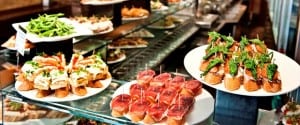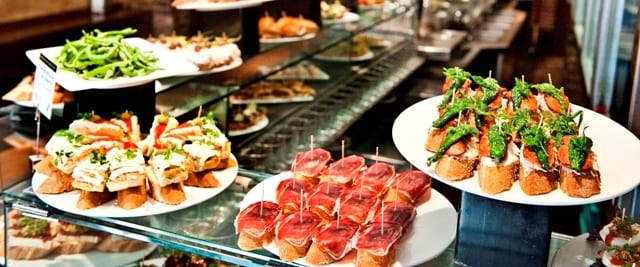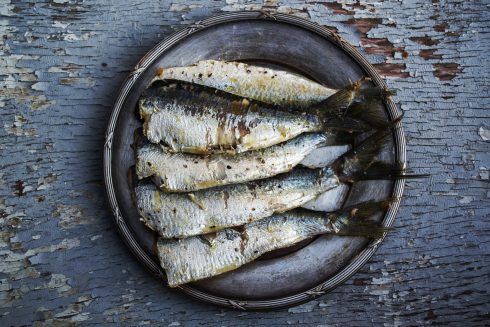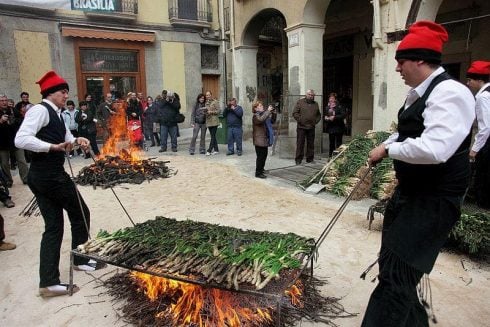 GALICIA – First catch your octopus
GALICIA – First catch your octopus
THEY go OTT for octopus in Galicia, the northwest corner of Spain, where no self-respecting tapas bar omits this delicious dish, now famous nationwide.
Ritualistically dipping the octopus in and out of boiling water in a copper pot makes the tentacles curl up nicely. The old method of beating it with a rock (don’t worry, not when it’s alive) will make it more tender.
Traditionally served on a wooden plate, it’s served with boiled potatoes and a few glugs of olive oil seasoned with sweet Spanish paprika. Simples!
ASTURIAS – Where the cider house rules
A WONDROUS, hearty worker’s lunch could sum up Asturias’ culinary identity, comprising cider and fabada, a rich, meaty bean stew.
Their famous flat, tart, 4-6%-proof cider is not so much a drink as a national treasure. Asturias is Spain’s largest cider producer, accounting for 80% and growing over 30 different apple varieties.
It is traditionally served estanciada – poured from a great height to aerate the drink. The drinker downs it in one but leaves a little at the bottom of the glass to tip on the floor.
The reason? Either to clean the glass or, as Celtic legend has it, to return to earth a little or what it has produced.
PAIS VASCO – Basking in gastro glory
A CORNERSTONE of Basque culture, pinchos (or to the Basques, pintxos) are the more elaborate older brother of tapas.
So-called because pinxto means ‘spike’, a toothpick pins ingredients to bread, from traditional tortilla to miniature ‘gastrotastic’ creations.
A serious sport in the Basque country, a pintxo crawl is not to be taken lightly – bars compete for coveted food trophies and tough competition keeps the culinary quality extremely high.
The Basque Country pintxo capital? San Sebastian.
CANTABRIA – Oceans of choice
WINDSWEPT Atlantic Cantabria, perching on the shores of the Bay of Biscay, unsurprisingly serves up an incredible array of seafood.
The coastline may look a bit like Britain but the culinary flavours are vibrant, spicy and rich. However, like the Brits, rich, hearty stews are a favourite, given the sometimes gloomy weather.
A speciality, almejas a la marinera – clams in a garlicky white wine sauce – is best with a crusty baguette to mop up the juice, and has become a Spanish favourite – especially at Christmas.
NAVARRA – Sausage heaven
THIS bright red sausage – a thin chorizo flavoured with garlic, salt and paprika – is Navarra’s speciality, best served fried or grilled.
Although the production of chistorra may be off-putting for the squeamish – made of minced pork (and sometimes beef) encased in lamb tripe or plastic – these piquant bangers are undeniably tasty.
They’re fast-cure sausages, usually dried for 2-25 days, and can reach up to a metre in length – a banger and a half!
ARAGON – Cuisine classics
LUSH, unspoilt Aragon, with more rivers than anywhere else in Spain, gets our vote for simple, classical cooking.
It is believed that lamb united the three cultures in the area – Muslim, Christian and Jewish – and the young lamb, served up as ternasco, is still a cultural point of reference.
The delicacy fardeles is, in layman’s terms, like a meatball married to a sausage. It’s made from pigs liver, seasoned with spices and wrapped in kidney skins.
CATALUNYA – A culinary cornucopia
IF you’ve ever been to La Boqueria fruit market in Barcelona, where sellers shout like fishwives over mountains of fresh fruit, you’ll understand how much pleasure the Catalans take in food.
Popular Catalan exports on the Spanish national menu include pan tumaca (tomato on bread) crema catalana (crème brulee), aioli (garlic sauce) and butifarra (a type of sausage).
Butifarra is made to ancient Roman recipes and exists in a glorious rainbow of variety: white butifarra made of lean meat, black butifarra containing boiled pork blood and even a yellow, egg-based version.
LA RIOJA – Wine and vine
LA Rioja is proof that the best things come in small packages: it covers just 5,000km2 but produces 250 million litres of internationally-acclaimed wine per year, and is incredibly rich in natural resources.
Man cannot live on wine alone, however, and typical cuisine includes patatas a la riojana (potatoes with chorizo) and chuletillas al sarmiento (lamb cutlets with vine shoots).
MADRID – Capital fare
THE king of winter stews, cocido madrileno is heavy on chickpeas, meats, vegetables and is of Jewish sephardic origin from the Middle Ages
Tradition dictates that the separate components – first the stock, then the vegetables and, finally, the meat – arrive separately. Sometimes the left-overs become the basis for croquetas, a tapa favourite.
CASTILLA LA MANCHA – Quixotic cuisine
DON QUIXOTE’S sidekick, Sancho Panza, was a well-fed fellow and, with his home turf being the birthplace of Manchego and migas (breadcrumbs with meaty titbits), that’s no surprise.
Whether or not marzipan was invented by Toledo’s nuns, knock at the entrance of any convent in the city and you will involve yourself in a behind-closed-doors trading operation the envy of the finest drug barons!
VALENCIA – Paella paradise
Paella Valenciana is Spanish gastronomy’s crowning glory, said to be born of a beautiful union between the Romans, who supplied the pan, and the Arabs, who brought the rice.
The legend goes that slaves of Moorish kings created the dish out of left-overs from royal banquets.
Valencia is rich in famous foods, together with oranges, turron (nougat) and lesser known horchata – a sweet, milky, almond and tiger nut drink.
EXTREMADURA – Pig out in style
ACORN-MUNCHING Iberian pigs abound in Extremadura, where the verdant landscape is a perfect habitat for them to roam.
For a leaner, much thicker variety of chorizo, morcon is an Extremadura delicacy.
MURCIA – A twist on tuna
PAPER-THIN slices of salt-cured tuna, mojama is a delicacy in Murcia and has been eaten for years by canny fishermen, curing their catch in order to preserve it.
Today we have fridges, but it is a mark of the appeal of the reddish-brown, firm fish that it is still a huge hit in the Mediterranean.
ANDALUCIA – Chilled with soup
GAZPACHO Andaluz is almost a national emblem. A raw tomato-based soup thickened with bread, it’s always served ice cold with a vegetable garnish. Originally a peasant dish, today it can be found in its many exotic forms, such as Michelin chef Dani Garcia’s cherry gazpacho.
Or try Moorish and more-ish ajo blanco, another chilled soup made of ground almonds, garlic, olive oil, vinegar and water, served with grapes or melon slices. Perfect for our long hot summers!











Thanks for that. Interesting.
horchata is not made with milk !!
“Milky” is used as an adjective here, describing the appearance of horchata, which indeed has a milky look. Containing, as the article states, tiger nuts and almonds.